Key Takeaways:
- Agentic AI refers to a type of AI systems that can autonomously plan, reason, make decisions, and take multi-step actions to achieve specific goals, much like a human agent would.
- Agentic AI use cases in contact centers include automating processes like customer issue resolution across voice and digital channels, outbound calling campaigns, qualifying leads, scheduling appointments, etc.
- Agentic AI and AI agents are closely related, but while AI agents typically follow predefined tasks, agentic AI is more autonomous, proactive, and can manage more complex workflows on its own, often orchestrating multiple AI agents.
- VoiceSpin leverages agentic AI in its AI voice agents and AI chatbots to enable them to perform real actions, resolve customer issues independently, and automate contact center processes and operations at scale.
Agentic AI has become a new buzzword in the contact center industry. But what does it really mean, how is Agentic AI different from AI agents and generative AI, and does it all matter in the context of contact centers?
If you’ve been struggling to keep up with all the latest AI innovations rolling out left and right and AI terms describing them, you’re not alone. In this blog, we’ll take a closer look at what agentic AI actually is, how it differs from AI agents and gen AI, and how agentic AI-powered chatbots and voice bots can truly automate your contact center operations effectively – without compromising on the quality of customer interactions. But first things first, let’s get back to the basics of agentic AI and what it means in contact centers.
What is Agentic AI?
Agentic AI refers to Artificial Intelligence systems that can operate autonomously. They don’t just respond to commands or answer questions – they can plan actions, make decisions, and execute tasks without constant human oversight. Basically, the term “agentic” emphasizes their capacity to act independently.
These systems often use Large Language Models (LLMs), Natural Language Processing (NLP), Machine Learning (ML), reinforcement learning, and other AI technologies, allowing them to understand context accurately, reason, plan, and ultimately execute multi-step processes.
In the contact center environment, agentic AI is simply a much more advanced version of traditional chatbots and voice bots. Imagine a basic rule-based chatbot that can only answer simple questions, direct your customers to self-help articles in your knowledge base, and transfer chats to human reps. In contrast, an agentic AI chatbot would act as an autonomous AI agent by handling the entire workflow (like resolving a customer support issue) from start to finish – all without human intervention.
What’s the Difference Between Agentic AI and Generative AI?
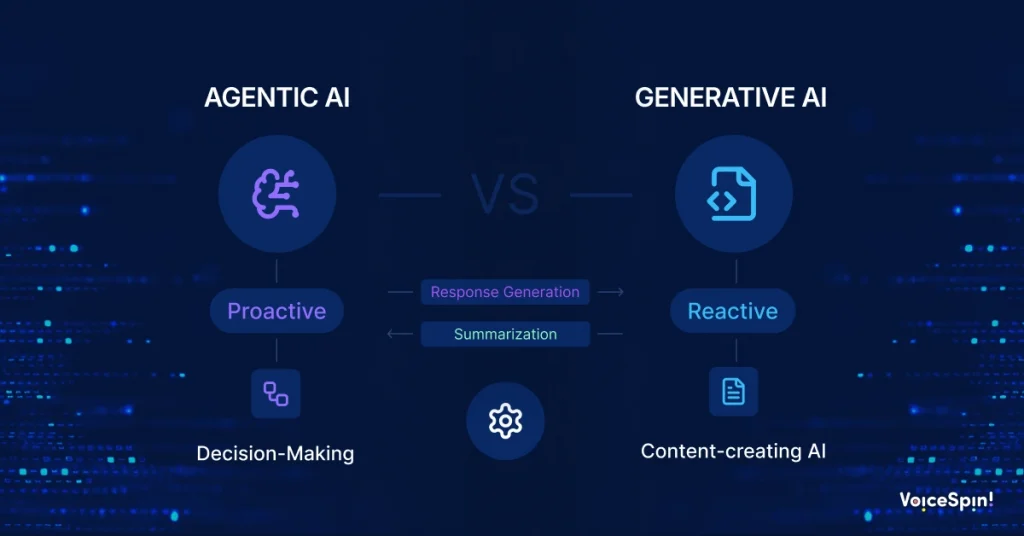
Let’s clarify the difference between agentic AI and generative AI. Firstly, what’s important to understand here is that agentic AI and generative AI aren’t opposing concepts – they are often complementary.
Generative AI (gen AI) is a type of Artificial Intelligence built to create new content based on patterns learned from its training data. Its primary function is to generate text, images, audio, video, and other types of media in response to human input (prompt). These are, for example, Large Language Models (LLMs) like GPT-4, Perplexity, or Gemini; image generators like DALL-E, Midjourney; code generators, etc. So, you’d typically use gen AI-powered tools to write marketing copy, draft emails, summarize documents, create images for presentations, or generate code snippets. Gen AI systems are reactive.
Agentic AI systems – as I’ve mentioned above – can autonomously make decisions, plan, and execute multi-step tasks, often with minimal or no human intervention. In fact, agentic AI often uses Generative AI as a tool. For example, an agentic AI chatbot built for customer service automation might use a gen AI model to understand user requests, generate natural, human-like responses, translate, and summarize customer conversations for human reps to take over. Gen AI is the cognitive engine driving an AI agent’s decision making. And unlike reactive gen AI tools, agentic AI systems are proactive.
IBM’s latest video does a great job explaining the difference between generative AI and agentic AI in a way that’s easy for anyone to grasp:
What’s the Difference Between Agentic AI and AI Agents?
Now, let’s cut through the confusion and define the key differences between agentic AI and AI agents. This one is a bit trickier. Actually, agentic AI and AI agents are closely related – and the two terms are very often used interchangeably. Yet, they refer to subtly different concepts.
An AI agent is an AI-powered software system that is built to perform specific, often well-defined tasks. AI agents can be reactive or proactive, simple or more complex, and may have limited autonomy. While agentic AI tools have a higher degree of decision-making, autonomy, and goal-driven behavior. They can orchestrate multiple AI agents, coordinate across different tools, and manage more complex workflows completely on their own. Plus, agentic AI systems can learn from past interactions and adjust their approach to improve performance over time.
You can think of agentic AI as a more advanced type of AI agents. In simple terms, all agentic AI systems are AI agents, but not all AI agents are agentic.
| Agentic AI | AI Agent | |
|---|---|---|
| Definition | An advanced class of AI systems that orchestrate multiple AI agents | A single (often specialized) AI program or component |
| Goal orientation | Goal-driven, solves problems on its own | Task-focused, follows set instructions |
| Autonomy level | Highly autonomous, can act independently | Limited autonomy, often needs human input |
| Decision making | Makes decisions based on reasoning and analysis | Follows programmed rules or makes decisions based on learned patterns within its narrow scope |
| Complexity | Handles multi-step tasks and complex workflows | Handles simpler, more structured tasks |
| Proactiveness | Highly proactive, initiates actions, and anticipates needs | Can be reactive or proactive |
| Learning capabilities | Continuously learns from past interactions and outcomes and improves | May learn and improve, often through programming updates or limited feedback loops |
| Example | An agentic AI chatbot that handles a customer’s request for a return or exchange from start to finish, without escalating to human reps | An AI chatbot that answers FAQs, provides information, resolves basic issues, and escalates complex queries to human reps |
What are the Most Common Agentic AI Use Cases in Contact Centers?
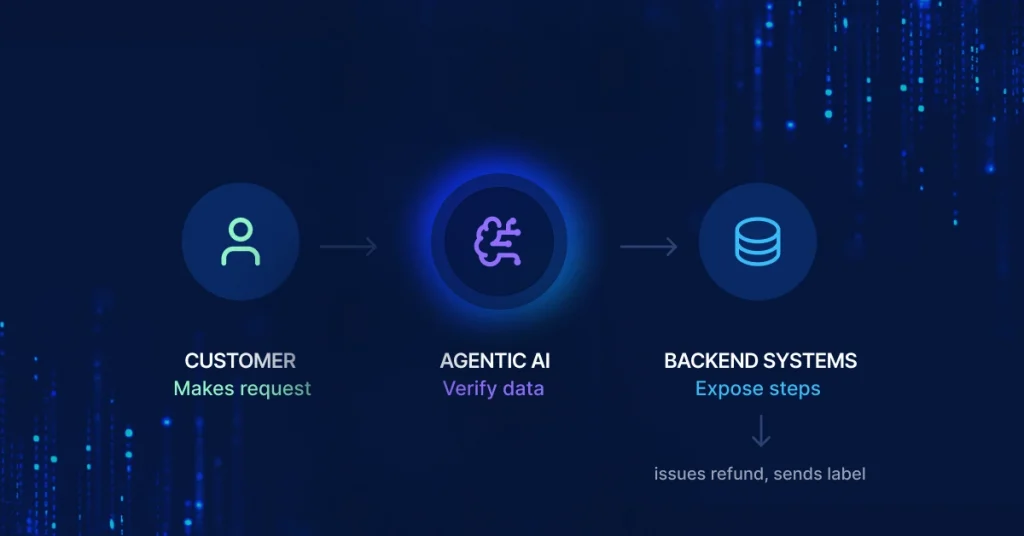
In contact centers, agentic AI agents can be used in a variety of scenarios and use cases, including customer support, lead qualification, calling campaigns, and process automation. And they help contact centers achieve a much higher level of automation and efficiency compared to using traditional AI systems. So, the most common use cases are:
Autonomous customer issue resolutions
While traditional AI chatbots excel at handling FAQs, delivering information, and helping users resolve basic requests, agentic AI solutions can handle more complex customer service requests, make autonomous decisions, and orchestrate a full issue resolution without escalating to a human rep. Here’s a quick example. Imagine a customer wants to return a damaged item.
An AI chatbot would ask for an order number, validate it, and then direct the customer to the standard return process for damaged items – and that would usually involve filling out a return form or escalating the request to a human support agent. An agentic AI chatbot would handle it with much greater autonomy and flexibility (while also delivering a much better customer experience along the way). It would:
- Verify the order and customer details
- Check the company’s policy for damaged items and the product’s value
- Offer an immediate and most convenient solution (a replacement or instant refund)
- Generate a return label if the item needs to be sent back for inspection (with no effort from the customer)
- Process the replacement order or refund independently
- Update all the relevant backend systems (CRM, an order management system, etc.)
Automated ticket/ email responses
Similarly, agentic AI tools can autonomously respond to customer emails/ tickets. They can analyze the entire content, sentiment, and urgency, understand customer intent, pull the relevant context from your CRM and past tickets, generate a highly personalized response (instead of using a generic template), and even offer proactive suggestions or incentives. Considering the volume of tickets support teams typically handle, automating even a portion of email replies can make things a lot easier for them.
Outbound calling campaign automation
The two previous scenarios were reactive. But as you already know, agentic AI can be highly proactive. Let’s take, for example, an agentic AI voice bot that can initiate and handle outbound calls automatically. You can use it for automating different types of proactive calling campaigns like:
- Cold calling and lead generation
- Targeted promotional offers
- Payment and debt collection
- Appointment reminders
- Service notifications (e.g., subscription renewals)
- Sales follow-ups
Automated lead qualification
Automated lead qualification is truly one of the most valuable applications of agentic AI in contact centers. Whether it’s responding to inbound leads or initiating proactive conversations with outbound leads, agentic AI bots can ask prospects a series of pre-qualification questions and identify their buying intent, specific needs, pain points, challenges they’re trying to solve, budget, or whatever criteria you’re interested in.
Then, an agentic AI bot will process all the collected information, score prospects based on their likelihood to convert, log all the data and outcomes in your integrated CRM system, and prioritize hot leads for immediate follow-up, or route them directly to your sales reps along with a brief summary of the interaction.
Process automation (scheduling, bookings, demo calls, etc)
Agentic AI can automate multiple business processes, like scheduling/ rescheduling appointments and demo calls, handling bookings, managing cancellations, and more. Let’s say, a prospect is looking for a software solution that your business provides. Here’s how their interaction with an agentic AI voice bot might look like when they call proactively:
- Agentic AI bot: Hi there, thanks for calling (Company Name). What can I do for you today?
- Prospect: Hi, I’m looking for project management software for my medium-sized marketing agency.
- Agentic AI bot: Excellent. Our project management software is built for teams like yours to help them collaborate better, streamline workflows, and deliver projects on time and within budget. Would you like me to schedule a demo call with one of our sales reps for a more detailed overview?
- Prospect: Yeah, that would be great. Can we do it tomorrow?
- Agentic AI bot: Absolutely! We’ve got a few open slots tomorrow at 10 AM, 3 PM, and 4 PM. Do any of those times work for you?
- Prospect: Okay, let’s do 3 PM
- Agentic AI bot: Perfect! Can I get your name and email address for booking?
- Prospect: Sure, my name is X, and my email address is Y.
- Agentic AI bot: Got it! I’ll go ahead and book that for you. You’ll receive a confirmation email shortly.
As you’ve seen above, agentic AI can check real-time availability, offer available slots, capture a prospect’s details, update the integrated calendar system, and send a confirmation email – all in one smooth flow and with no human agent intervention.
How VoiceSpin Leverages Agentic AI in its Contact Center Solutions
At VoiceSpin, we’ve always been leveraging the latest in AI technology when improving our existing contact center solutions and creating new ones. That’s why, we’ve naturally built our AI voice bot and chatbot agents using agentic AI. And these solutions are truly redefining what’s possible today in contact center automation, for both text-based and voice interactions. Here’s why our AI voice agents and AI chatbots are worth your attention:
- RAG-based: Powered by RAG (Retrieval-Augmented Generation), our AI agents can instantly pull relevant data from your integrated knowledge sources and deliver more accurate, context-aware responses, reducing AI hallucinations and improving customer experiences.
- Perform actions: Apart from just answering questions and providing information, our AI agents can integrate with your CRM, calendar software, and other back-end tools and perform real actions, helping you automate order processing, scheduling, lead qualification, and other tasks.
- Easily scalable: No matter the volume of calls or chats you need to handle, our AI agents are highly scalable – they can handle dozens, hundreds, or thousands of text/ voice interactions simultaneously (without compromising on quality) and instantly scale based on your demand.
- Work alongside human reps: Our solutions can work autonomously or alongside your team. Whenever human assistance is needed – they can smoothly escalate conversations to your team members without losing any context, so your reps can easily pick up from where the bot left off.
- More than standalone tools: On top of it all, VoiceSpin’s AI agents aren’t delivered as standalone solutions. They are part of our broader contact center software ecosystem, including cloud telephony, predictive dialing, omnichannel messaging, AI speech analytics, and other tools.
Book a demo call now to learn more about VoiceSpin’s agentic AI contact center solutions and what they can do for your business in terms of process automation and cost reduction.
Frequently Asked Questions
How does agentic AI work?
Agentic AI works as an autonomous agent that can reason, make decisions, and take multi-step actions to achieve specific goals with minimal or no human intervention. An agentic AI system doesn’t just react to prompts – it decides what to do next based on user intent, context, and desired outcomes, mimicking how a human agent might think and act. Agentic AI interacts with various back-end systems and tools and coordinates actions across them to complete tasks.
What are the benefits of agentic AI in contact centers?
First and foremost, agentic AI tools like voice agents and chatbots can automate repetitive tasks, deliver 24/7 customer support, and handle customer requests independently. That reduces the load on your team and allows your human reps to focus more on higher-value tasks and more complex customer interactions. Better yet, these tools can handle hundreds or even thousands of chats or calls simultaneously, so you can easily scale your operations – without having to hire more human reps – and reduce your operational costs.
What are the challenges of implementing agentic AI in contact centers?
When it comes to deploying agentic AI systems in contact centers, maintaining data privacy and security is a primary challenge because these systems process vast amounts of sensitive data. And that is particularly critical for businesses operating in highly regulated industries like healthcare, banking, and finance. Integration complexity is another major challenge, as implementing agentic AI requires a well-integrated tech stack and access to reliable data sources.
Can agentic AI replace human agents?
In short, yes, but not entirely. As agent-based AI systems are becoming more advanced and sophisticated, they are capable of handling more complex tasks with minimal human oversight. But they still lack the empathy, judgment, creativity, and nuanced problem-solving that human reps bring to the table. The best strategy is to have agentic AI work alongside your human reps, with AI handling repetitive or predictable requests, while escalating more challenging interactions to human agents.

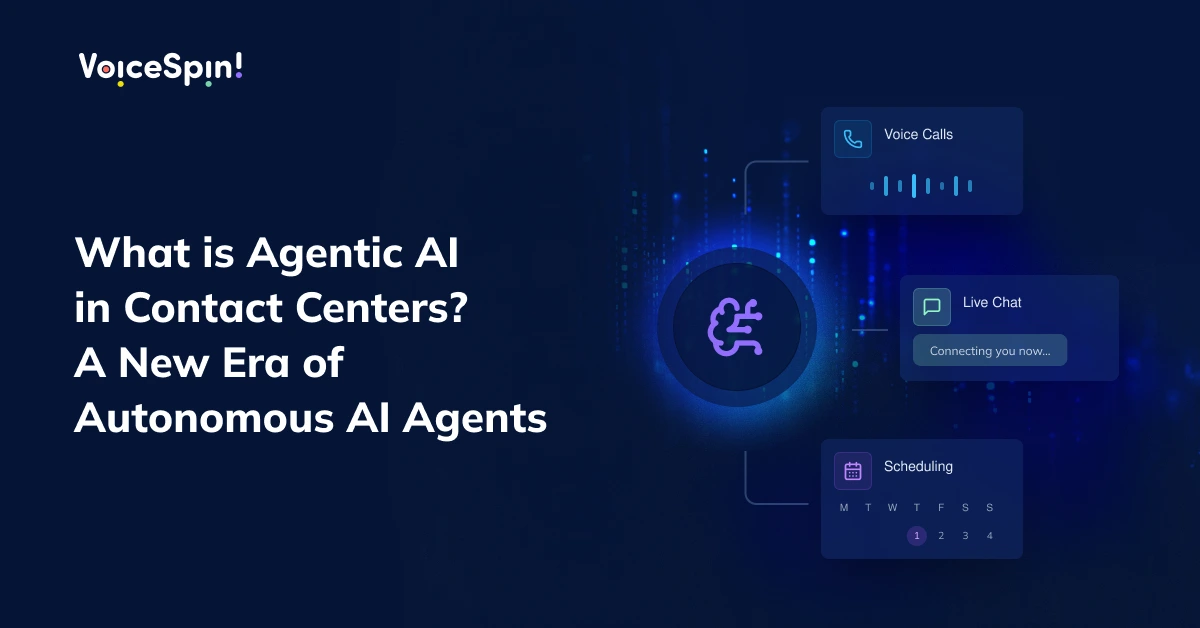
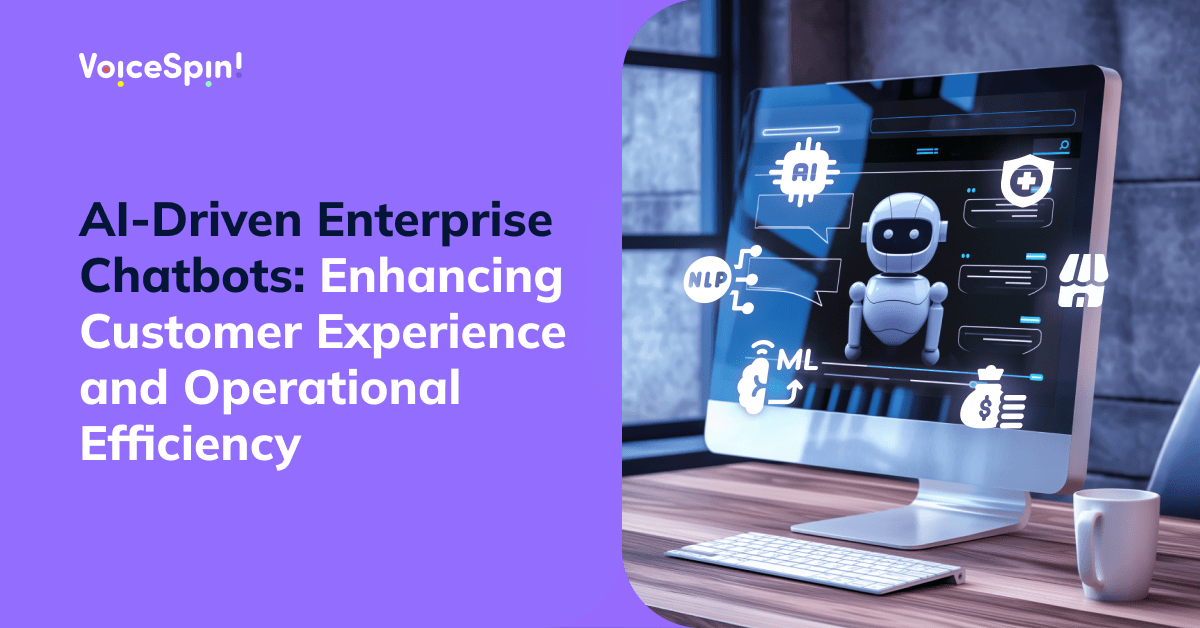
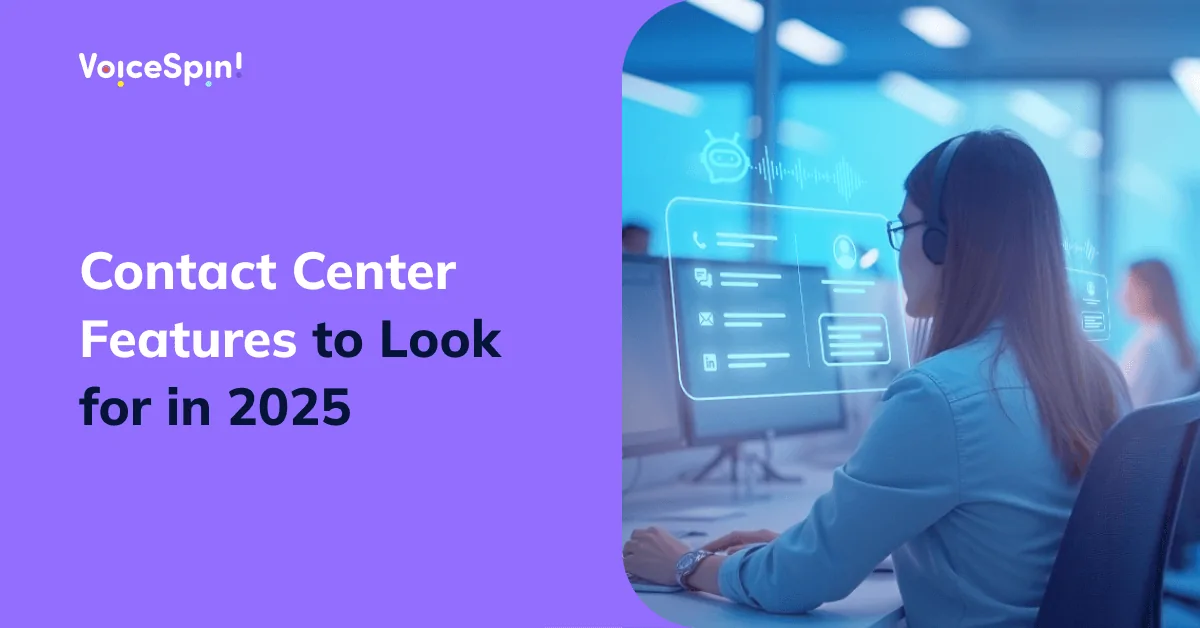

 +18889082995
+18889082995
 +442036084160
+442036084160
 +97237237006
+97237237006